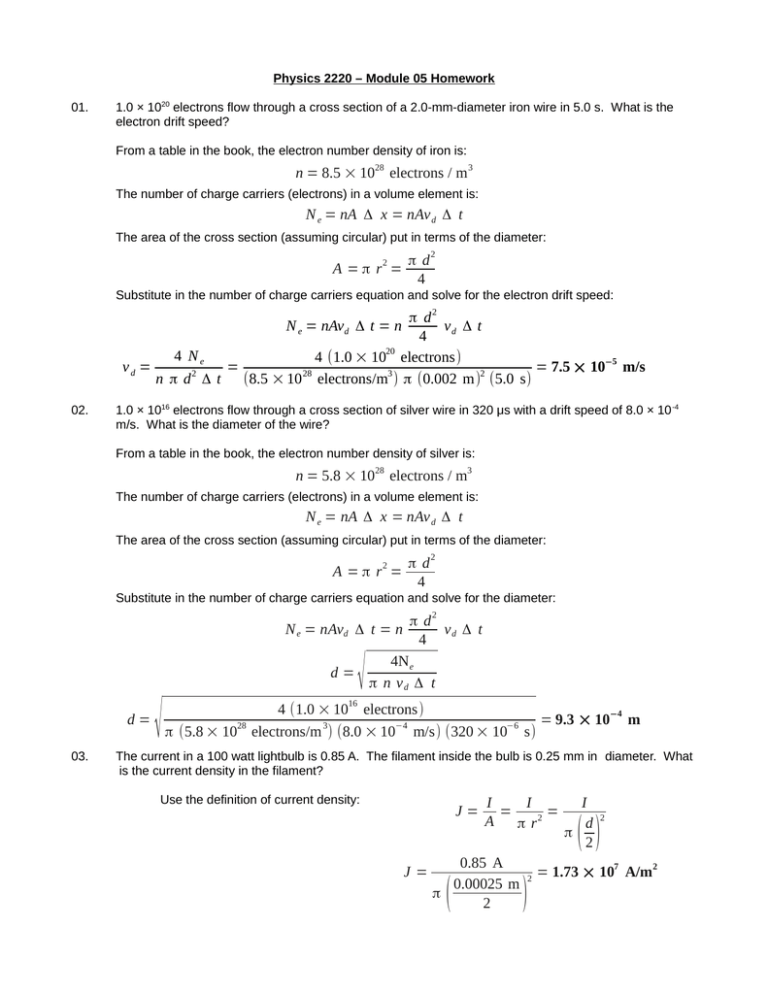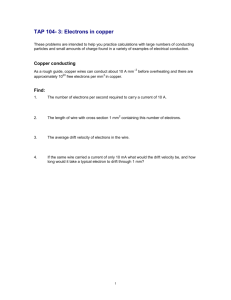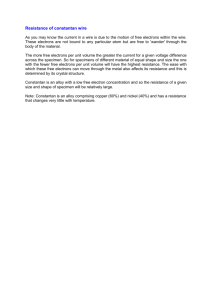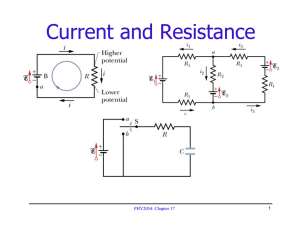Physics 2220 – Module 05 Homework
advertisement

Physics 2220 – Module 05 Homework 01. 1.0 × 1020 electrons flow through a cross section of a 2.0-mm-diameter iron wire in 5.0 s. What is the electron drift speed? From a table in the book, the electron number density of iron is: n = 8.5 × 1028 electrons / m 3 The number of charge carriers (electrons) in a volume element is: N e = nA Δ x = nAv d Δ t The area of the cross section (assuming circular) put in terms of the diameter: 2 A =π r = π d2 4 Substitute in the number of charge carriers equation and solve for the electron drift speed: π d2 vd Δ t 4 4 Ne 4 (1.0 × 1020 electrons) vd = = = 7.5 × 10−5 m/s 2 28 3 2 n πd Δt (8.5 × 10 electrons/m ) π (0.002 m) (5.0 s) N e = nAvd Δ t = n 02. 1.0 × 1016 electrons flow through a cross section of silver wire in 320 μs with a drift speed of 8.0 × 10 -4 m/s. What is the diameter of the wire? From a table in the book, the electron number density of silver is: n = 5.8 × 1028 electrons / m3 The number of charge carriers (electrons) in a volume element is: N e = nA Δ x = nAv d Δ t The area of the cross section (assuming circular) put in terms of the diameter: 2 A =π r = π d2 4 Substitute in the number of charge carriers equation and solve for the diameter: 2 N e = nAvd Δ t = n d= d= 03. √ 16 √ πd vd Δ t 4 4Ne π n vd Δ t 4 (1.0 × 10 electrons) = 9.3 × 10−4 m 3 −4 −6 π (5.8 × 10 electrons/m ) (8.0 × 10 m/s) (320 × 10 s) 28 The current in a 100 watt lightbulb is 0.85 A. The filament inside the bulb is 0.25 mm in diameter. What is the current density in the filament? Use the definition of current density: J= J= I I = = A π r2 0.85 A 0.00025 m π 2 ( 2 ) I d π 2 2 () = 1.73 × 107 A/m2 04. 2.0 × 1013 electrons flow through a transistor in 1.0 ms. What is the current through the transistor? Start with the definition of current: I= Δ Q (nAv d Δ t) q = Δ t Δ t The number of charge carriers (electrons) in a volume element is: N e = nA Δ x = nAvd Δ t Substitute into current equation and solve for current: I= 05. N e q (2.0 × 10 13 electrons) (1.60 × 10−19 C) = = 3.2 × 10−3 A = 3.2 mA −3 Δ t 1.0 × 10 s A 3.0-mm-diameter wire carries a 12 A current when the electric field is 0.085 V/m. What is the wire's resistivity? E J =σ E = ρ Use Ohm's Law and the definition of current density: J= I A Combine and solve for the resistivity: E I ρ = A 2 EA E π d 2 (0.085 V/m) π (0.003 m) ρ= = = = 5.0 × 10−8 Ω m I 4I 4 (12 A) 06. A 0.50-mm-diameter silver wire carries a 20 mA current. What are: Note the resistivity of silver and number density: σ = 6.2 × 107 Ω−1 m−1 n = 5.8 × 10 28 electrons/m3 (a) The electric field in the wire Use Ohm's Law and the definition of current density: J =σ E J= I A Combine and solve for the electric field: 4 (20 × 10−3 A) J I 4I E= σ = = = = 1.64 × 10− 3 V/m 2 2 7 −1 −1 A σ π d σ π (0.00050 m) (6.2 × 10 Ω m ) (b) The electron drift speed in the wire? Start with the definition of current: n vd q π d2 Δ Q (nAv d Δ t) q I= = = nAv d q = Δ t Δ t 4 Solve for the electron drift speed: 4 I nq π d 2 4 (20 × 10−3 A) = 1.1 × 10−5 m/s 3 −19 2 electrons/m ) (1.6 × 10 C / electron) π (0.00050 m) vd = vd = (5.8 × 10 28 07. A 1.5 V battery provides 0.50 A of current. (a) At what rate (C/s) is charge lifted by the charge escalator? The rate charge is lifted by the charge escalator is a fancy way of saying current. I= (b) Δ Q = 0.50 C/s = 0.50 Amps Δ t How much work does the charge escalator do to lift 1.0 C of charge? Think the battery (external force) is doing the work. W = Δ U = q Δ V = (1.0 C) (1.5 V ) = 1.5 J (c) What is the power output of the charge escalator? Use the definition of power: P= 08. (a) W Δ U QΔ V = = = I Δ V = (0.50 A) (1.5 V) = 0.75 W Δ t Δ t Δ t How long must a 0.60-mm-diameter aluminum wire be to have a 0.50 A current when connected to the terminals of a 1.5 V flashlight battery? Note for a aluminum wire: σ = 3.5 × 107 Ω−1 m−1 ρ = 2.8 × 10−8 Ω m Use Ohm's Law and the definition of resistance. ρ L A I ρ L 4I ρ L Δ V= = 2 A πd Δ V = IR R= Solve for the length of the wire: (1.5 V ) π (0.00060 m)2 Δ V π d2 L= = = 30 m 4I ρ 4 (0.50 A) (2.8 × 10−8 Ω m) (b) What is the current if the wire is half the length? Use the same equation and solve for the new current I= 09. (1.5 V) π (0.00060 m)2 Δ V π d2 = = 1.0 A 4L ρ 4 (15 m) (2.8 × 10−8 Ω m) You need to design a 1.0 A fuse that “blows” if the current exceeds 1.0 A. The fuse material in your stockroom melts at a current density of 500 A/cm2. What diameter wire of the materiel will do the job? Use current density and solve for the diameter: J= d= √ √ I 4I = A π d2 4 (1.0 A) 4I −4 = = 5.0 × 10 m = 0.50 mm 2 2 π J π (500 A/cm ) (100 cm/m)




